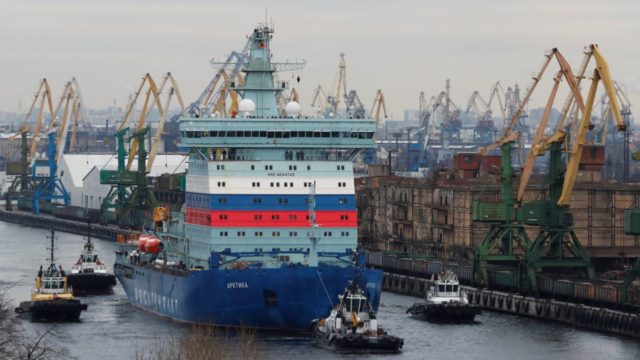
Kremlin’s Much-Ballyhooed Icebreaker Project in Real Trouble
Publication: Eurasia Daily Monitor Volume: 17 Issue: 135
By:

As is often the case, much of the Western coverage of the launch of Russia’s new nuclear-powered icebreaker, the Arktika, has relied heavily on Kremlin press releases, with little to no examination of the actual situation. The vessel is the world’s largest of its type to date and the first of what is slated to be a fleet of six by the middle of this decade. While it is true that the Arktika was put to sea in mid-September, it was almost four years behind schedule; moreover, one of its three engines was inoperable and other equipment did not work after an earlier testing accident. Rosatomflot, which will operate the Arktika-class fleet, has already brought three suits against the shipyard involved for failure to deliver the ship fully ready and in a timely fashion (Atomic-energy.ru, August 11). None of this was a surprise to the Russian expert community, some of whose members had warned earlier this year that the new icebreaker was not ready to sail and should be returned to the shipyard for serious refitting (The Barents Observer, April 20).
Worse still from Moscow’s point of view, all indications are that the other five icebreakers in this new class are likely to be delivered late if at all. Such news casts further doubt on Moscow’s plans to dramatically expand the use of the Northern Sea Route (NSR), which skirts Russia’s northern coast, and undermine the government’s economic development strategy for the Arctic seafloor. Additionally, the problems with new icebreaker construction will weaken Russia’s ability to maintain exclusive dominance over the NSR given China’s more successful development of comparable ice-clearing vessels over the last two years (see EDM, June 12, 2019). All this has led some Russian outlets to describe the situation as “the collapse” of the latest Kremlin “mega-project” (Sovetskaya Rossiya, September 19, 2020). Perhaps the only trend likely to boost Moscow’s domineering position in the High North is global warming, which continues to reduce the seasonal extent and thickness of Arctic sea ice cover, thus making the new icebreakers Russia has announced less necessary than many believed only a few years ago. Indeed, Russian experts told President Vladimir Putin at a high-level meeting last week (September 23) that Moscow should press ahead with Arctic development even before all the new icebreakers are in hand given how quickly average polar temperatures are rising (Kremlin.ru, September 23).
On paper, the Arktika and other new Russian icebreakers are as impressive as Moscow claims and Russian media repeat (Sovershenno Sekretno, September 18). But construction, like most of Russia’s naval development, is well behind schedule and plagued with massive cost overruns. Consequently, the cash-pressed Russian government has already canceled some shipbuilding projects and faces the task of refitting those it has already accepted. So even though Moscow currently says that the next generation of icebreakers will come online between 2021 and 2027, some Russian experts argue a more realistic timeline could stretch at least a decade longer (Krizis-kopilka.ru, Sovross.ru, September 19).
The Barents Observer, the most consistently attentive and accurate reporting outlet on these issues, recently asserted that Russia’s repeated launches of shipbuilding projects in the Arctic before they are fully ready is “more of a political statement” than anything else—and should be evaluated as such (The Barents Observer, September 11).
The Arktika is scheduled to break through sea ice north of the Franz Jozef archipelago and then return to Murmansk in early October. But with only two of its three screws turning, it likely will be unable to break through ice 2.2 meters thick (as it was designed to do); and the vessel may suffer other indignities because much of its onboard equipment was damaged during a brief sea trial several months ago. According to Rosatomflot, far from all the systems that were damaged have been fully repaired (Rosatom.ru, December 12, 2019 and September 22, 2020; Kommersant, February 10, 2020).
The ship’s actual (as opposed to projected) performance will not be known until after the current sea trials conclude. But a report about another major Russian nuclear-powered ship in the Arctic last month gives little reason for optimism. Namely, a new atomic cargo ship that Moscow had boosted as heralding a breakthrough in achieving Putin’s NSR goals by 2024 failed utterly. It carried only about 20 percent of the cargo it is rated at, possibly because of falling demand as a result of the pandemic but also because its operators did not want to load the ship too heavily before being more confident about its operations (The Barents Observer, September 11; Rosatomflot.ru, September 8; Kamchatinfo.com, September 7).
The problems now plaguing the Arktika and Russia’s icebreaker fleet development more generally are part and parcel with the problems facing Russia’s naval construction as a whole, according to Aleksandr Ivanin, a leading Moscow specialist on military equipment. In an article published last month, he argues that these problems are now so deep-seated that the gap between what Moscow announces it is going to do and what it in fact is capable of in this sector is rapidly widening. In Ivanin’s estimation, there is little likelihood this will change for the better in the near future (Nezavisimaya Gazeta, August 7). It is important to keep this in mind whenever Moscow announces any breakthrough in naval construction (see EDM, June 18, 2019)—and nowhere more so than in the case of Russian icebreakers.



